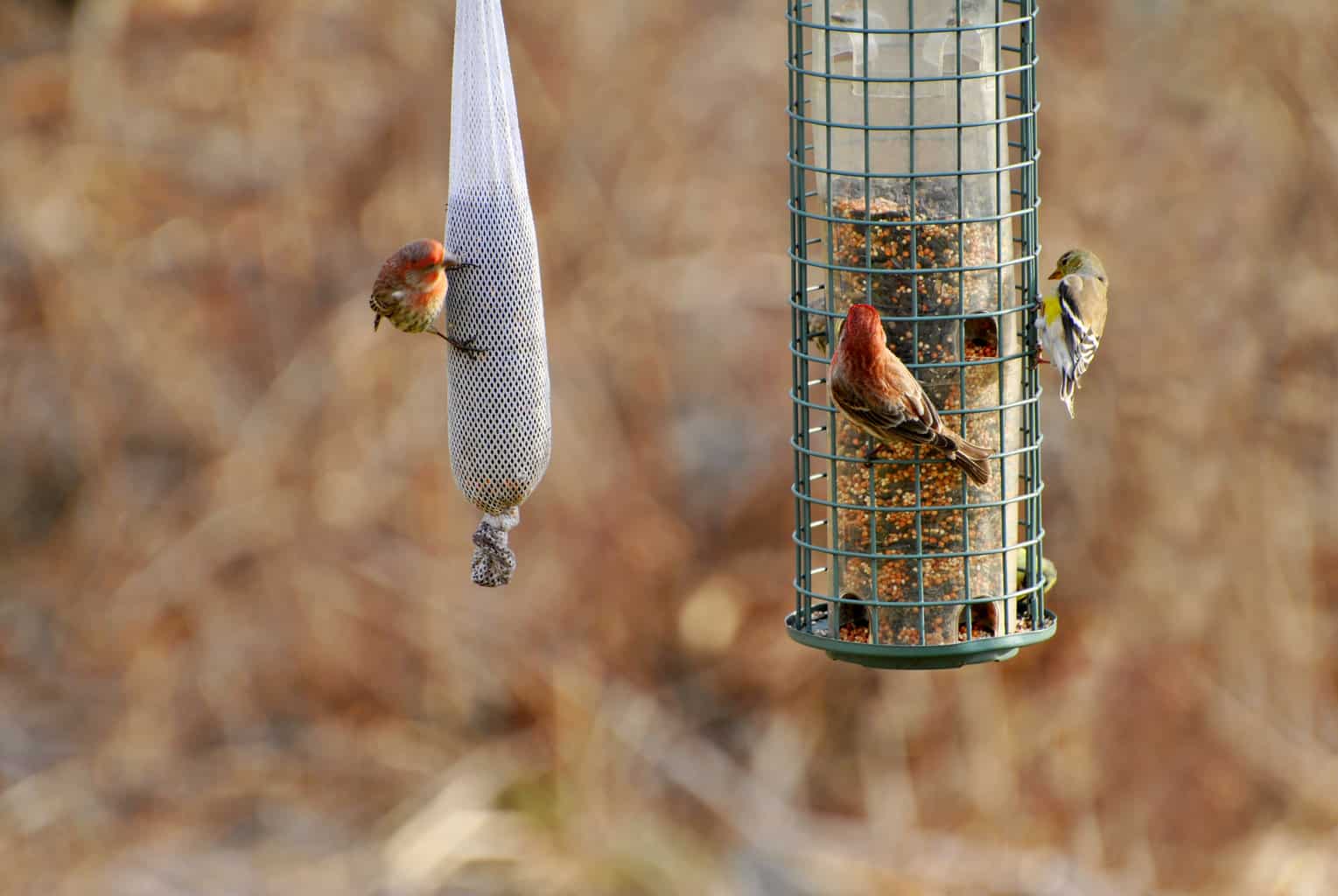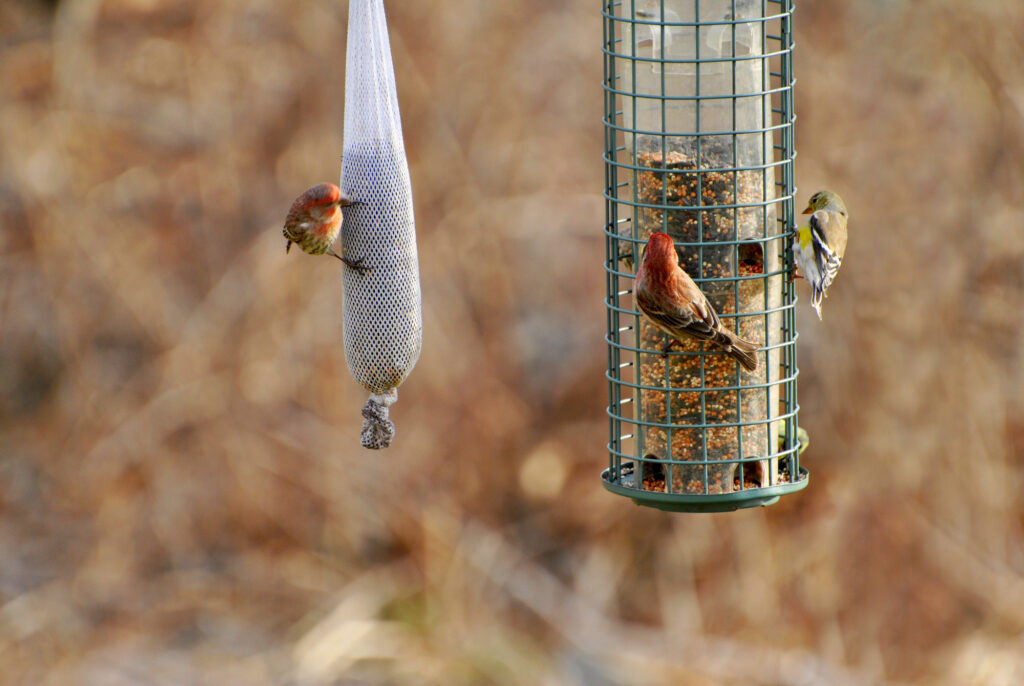Feeding wild birds in your backyard over the autumn months isn’t just about making sure your feeders are well stocked.
Though this is part of the picture, it’s also very important to make sure that there are natural sources of food on your property that wild birds can take advantage of as the weather begins to turn and leaves begin to fall.
What’s Going On in a Backyard During Autumn?
Understanding the natural cycles of the autumn season will help you understand how best to support the wild birds with whom you share your space.
Of course, you also need to think about what’s going on in the avian kingdom. Understanding what birds are doing at this time of the year will also be vital in helping you see how to help them.
In the autumn, one key thing to think about is what wild foods are available to birds foraging in your garden.
There may well be numerous berries and fruits ripening on native plants in your area – and there are plenty – both those we ourselves eat and those we do not – that will be an attractive food source for birds at this time of year.
In an autumn garden, there are likely to be a number of grasses and perennial plants going to seed, which is also a valuable food source for many birds.
We should also pay some mind to insect life in our backyards, and note how this changes throughout the year.
As autumn wears on, a number of species may benefit from the insect life that toils as decomposers in the ground layers of your garden, helping to return nutrients to the soil system as the leaves of deciduous trees, shrubs, and other vegetation break down
Another key thing for autumn birdwatchers to consider is what autumn birds might be doing at this time of year.
Species present in your area year-round might, for example, be storing as much energy as possible for the colder months to come. So, like the birds in winter, they will need plenty of fats and proteins.
Another notable thing about autumn is that many migratory species may be getting ready for their long journeys, or be on their migration routes.
These birds also require plenty of fats, proteins, and other essential nutrients to make sure that they are in tip-top health for their journeys.
Providing Natural Food Sources Through Autumn Planting
Ideally, to feed your feathered friends this autumn, you should already have planted a wide range of plants in your garden to cater to the needs of the birds in your area.
Along with providing food sources, the right planting scheme can also provide birds with the other things they need – shelter, places to perch, nesting habitat, etc.
But even if your garden still leaves something to be desired as a bird-friendly space, it’s not too late to start doing something about it.
This year, you can plant some native species of trees, shrubs, and other perennial plants that, though they may not help the resident birds and migrating visitors this autumn, will help and feed them over many years to come.
In temperate climates, autumn is often a good time to source and plant bare-root species. So, research some bird-friendly natives in the area where you live that will be suited to the growing conditions in your particular backyard, and get planting!
Key categories of plants that are extremely beneficial in providing food for wild birds in autumn include:
- Certain fruit and nut trees.
- Some autumn-fruiting shrubs, berry bushes, and fruiting canes and vines.
- Autumn flowering perennials (that cater to nectar-supping birds on migration, and also attract pollinating insects that some birds like to eat).
- Flowering perennials and grasses that set seed in autumn (providing food for seed-eating bird species).
- Aromatic herbs, groundcover plants, and other plants that are able to encourage a rich biodiversity of insect life.
Remember: before you think about placing bird feeders and filling them with appropriate food supplies for wild birds, you should always think about providing food through the plant choices you make first.
Maintaining an Existing Garden to Feed Wild Birds in Autumn

Another thing to think about is how you should maintain your existing garden to feed wild bird species.
Rewild Your Lawn – Don’t Mow It
This practice will be a welcome treat for birds, and you will attract different birds who don’t normally come to feeders but prefer to eat from the ground in more sheltered areas.
With a few bushes, trees, and naturally growing grass, create a small “wild area” in your yard.
This area will make a treasure spot for birds and will surprise you with how many birds will show up that you haven’t had before.
Butterflies and other insects will love it too, which will in turn invite even more birds for you to enjoy like thrushes and warblers.
If you invite some of your neighbors to join you in letting small wild areas develop in their yards adjacent to yours, then an exciting wildlife refuge could develop for all to enjoy!
Leave Wild Corners and Unmanaged Areas
It’s not just your lawn that could benefit birds by being a bit less managed and tidy. Leaving other wild and less managed areas in your garden can help to boost biodiversity and add food for wild birds.
Even embracing weeds in some parts of your garden could be immensely beneficial for birds, and for the other wildlife that shares your space.
Weeds are often native plants incredibly well adapted to our areas, and they can sometimes be among the most wildlife-friendly plants.
Don’t Deadhead Too Zealously
Many gardeners pride themselves on their careful management and neat and tidy gardening habits.
Deadheading flowering plants can often be beneficial for the plants themselves and can prolong the blooming period, which can be beneficial for pollinators, other insects, and for you.
Sometimes, however, gardeners deadhead for purely cosmetic reasons, or deadhead for too long, preventing a species from setting seed at the end of the blooming season. This isn’t as good for a bird-friendly garden.
Deadheading a little less zealously can mean that you have plenty of plants setting seed. Often, this provides a bountiful source of food for birds and other wildlife.
With some plants, such as roses, you won’t get hips (fruits) if you deadhead too zealously, which depletes the natural food abundance of an autumn garden.
Don’t Cut Back Herbaceous Perennials in Autumn
Another common practice among many gardeners is to cut back herbaceous perennials when they begin to die back in the autumn months. However, leaving these to stand until spring can bring benefits to the birds and other wildlife in your garden.
As well as leaving seeds that some birds like to eat, leaving the dead and dying foliage of these plants in place can also provide shelter and habitat for a wide range of creatures.
This is just one more way to make your garden more eco-friendly and to cater to the creatures around you through your gardening decisions.
Preparing Bird Feeders For Autumn
Of course, along with thinking about natural food sources in our gardens in autumn, we can also think about supplementing the diet of wild birds with appropriate foods offered in bird feeders or at bird feeding stations.
First of all, remember that existing feeders should always be cleaned on a regular basis, at the beginning of each new season, and ideally more frequently.
Make sure you do a deep clean on all bird-feeding equipment and other bird-friendly features, such as bird roosting or nesting boxes, bird baths, etc. that you might have added to your garden.
Check the condition of bird feeders and replace any that are no longer fit for use.
Next, you’ll need to think about what bird food you should place in feeders to meet the needs of the birds you will encounter in autumn.
Remember, birds preparing for winter and migrating species are in special need of fats and proteins to sustain them.
How to best provide those things will depend on the specific bird species that are present where you live.
However, fat balls made with either animal fats or certain high protein, high-fat vegetarian options can be wonderful for many birds at this time of the year, during the migration period, and as colder weather arrives.

